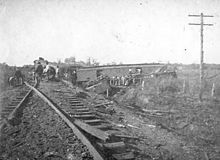Casey Jones (engine driver)
John Luther Jones (born March 14, 1863 in Missouri , † April 30, 1900 ), called Casey Jones , was an American train driver who achieved fame for his heroic actions in a railroad accident.
Life
Early years
John Luther Jones grew up in southwest Missouri and later moved with his family to Cayce, Kentucky . At the age of fifteen he began to work in a telegraph office for the railroad , where his colleagues called him Casey - after his hometown. From 1890 he was a locomotive driver on the Illinois Central Railroad (ICRR) and soon gained particular fame for a six-tone whistle that he had installed on his steam locomotive .
The "Cannonball"
In 1900, Jones was offered a job as a train driver on the famous Chicago - New Orleans passenger train , unofficially known as the "Cannonball" (cannonball). On April 29 of the same year Jones was asked to take over the "Cannonball" which he had just driven to Memphis (Tennessee) for the return trip to Canton (Mississippi) 183 miles away due to the absence of the regular train driver . The departure was delayed by 95 minutes due to repairs. Jones wanted to catch up and drove faster than usual. After a hundred miles he had already caught up an hour; Fifty miles later it was almost back on schedule. Determined to get to Canton on time, he drove at full speed 70 miles an hour - all the while sounding his famous whistle. Other trains were also late that evening, and a backlog was expected in the small town of Vaughan . All the train drivers, including Jones, knew this and had been instructed exactly how to maneuver their trains.
accident
Before the introduction of modern signaling systems , the correct maneuvering of men with signal flags and consistent monitoring of the route was guaranteed. Despite careful planning, one of the shunting trains broke down and four of its wagons were left on the “Cannonball” route. A shunter waved his lantern vigorously as Jones' train passed, but Jones assumed that the unexpected signal should mean clear travel . When the view of the station opened around a bend, Jones's stoker , Simeon T. Webb , saw the lights of the parked train a few hundred meters away. Jones ordered Webb, "Jump, Sim, jump," which Webb did about a hundred yards before the impact. Jones stayed on the machine, although he succeeded in reducing the speed of the "Cannonball" considerably, but not in bringing the locomotive to a standstill in time. The train raced into the last two freight cars of the train in front of him. Jones was the only one dead.
myth
The courageous action made Casey Jones famous. Wallace Saunders, a railroad shunter who had known the engine driver, rewrote the text of an older ballad in the style of Jones' story; In this version, the song achieved great popularity in the USA and later in the entire English-speaking world.
The United States Postal Service issued a commemorative stamp in honor of Casey Jones . The British singer Brian Cassar became known in the context of the beat of the early 1960s under the pseudonym Casey Jones , his backing band was called The Engineers (the English word also describes the profession of train driver).
The accident was also processed in the entertainment media, for example in the Disney cartoon The brave engineer and in The Real Ghostbusters episode Last Train in Eternity , in which the ghost of Casey Jones tries to repeat the fateful journey and prevent the accident.
The title Casey Jones from the Grateful Dead , first appeared on the 1970 album Workingman's Dead , is also based on the incident.
In the German-speaking countries, two book titles with adventure stories appeared in the early sixties, namely Casey Jones the engine driver. Narrated for the youth and Casey Jones is driving again , both by the author Margret Haas.
Web links
- Casey Jones Museum (English)
- The Ballad of Casey Jones (English)
- The Ballad of Casey Jones sung by Johnny Cash
- ZeitZeichen : 03/14/1864 - Birthday of the train driver Casey Jones
| personal data | |
|---|---|
| SURNAME | Jones, Casey |
| ALTERNATIVE NAMES | Jones, John Luther (maiden name) |
| BRIEF DESCRIPTION | American train driver |
| DATE OF BIRTH | March 14, 1863 |
| PLACE OF BIRTH | Missouri , USA |
| DATE OF DEATH | April 30, 1900 |


